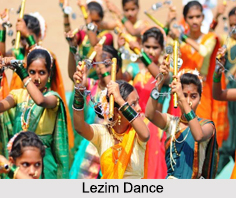 Lezim is a folk dance of Maharashtra where the dancers carry a small musical instrument with jingling cymbals called the "Lezim". The dance is named after this instrument. It is the state"s traditional folk dance performed during Gudi Padwa day in every nook and corner of the city. The dance is a treat to watch and enjoy. Lezim Dance is frequently used as a fitness drill by schools in Maharashtra, militias and other institutions because it involves many callisthenic moves and can be quite strenuous.
Lezim is a folk dance of Maharashtra where the dancers carry a small musical instrument with jingling cymbals called the "Lezim". The dance is named after this instrument. It is the state"s traditional folk dance performed during Gudi Padwa day in every nook and corner of the city. The dance is a treat to watch and enjoy. Lezim Dance is frequently used as a fitness drill by schools in Maharashtra, militias and other institutions because it involves many callisthenic moves and can be quite strenuous.
The first Lezim performance to an international audience was presented at the 9th Asian Games in the year 1982 at Delhi where 400 of the best Maharashtrian Lezim players gave a demonstration.
Performance of Lezim Dance
Earlier, there were a few variations of the Lezim practiced in the villages of Maharashtra; however these are hardly ever used today.
In Lezim dance, there are various types of movements like stepping, hopping, squatting and bending. Every movement of the dance is executed in perfect time with the proper strikes which is swung in four or eight counts. This provides a rhythmic accompaniment to the dance. The Lezim dances and their specific gestures, movements have been adapted by the physical culturists in their exercises in the drive for beautiful body.
The rural form of the dance usually consists of Lezim dancers in two rows, repeating a sequence of steps, changing the steps every few beats. Thus, a 5-minute Lezim performance consist of 25 different steps danced in harmony. Other variations include dancing the Lezim in four rows, in a single circle formation, or in concentric circles formations (similar to the Garba Dance), with each dancer twirling and dancers of opposite rows often playing Lezim with each other. Changes in steps are "announced" by a ring leader using a whistle.
Musical Instruments for Lezim Dance
Dholki, a drum instrument is used to accompany this dance form. Apart from the Lezim and Drum, it includes Halagi and Cymbals as musical instruments during the dance performance. The dancers wear colourful costumes. Lezim is frequently used as a fitness drill by schools, militias and other institutions.



















